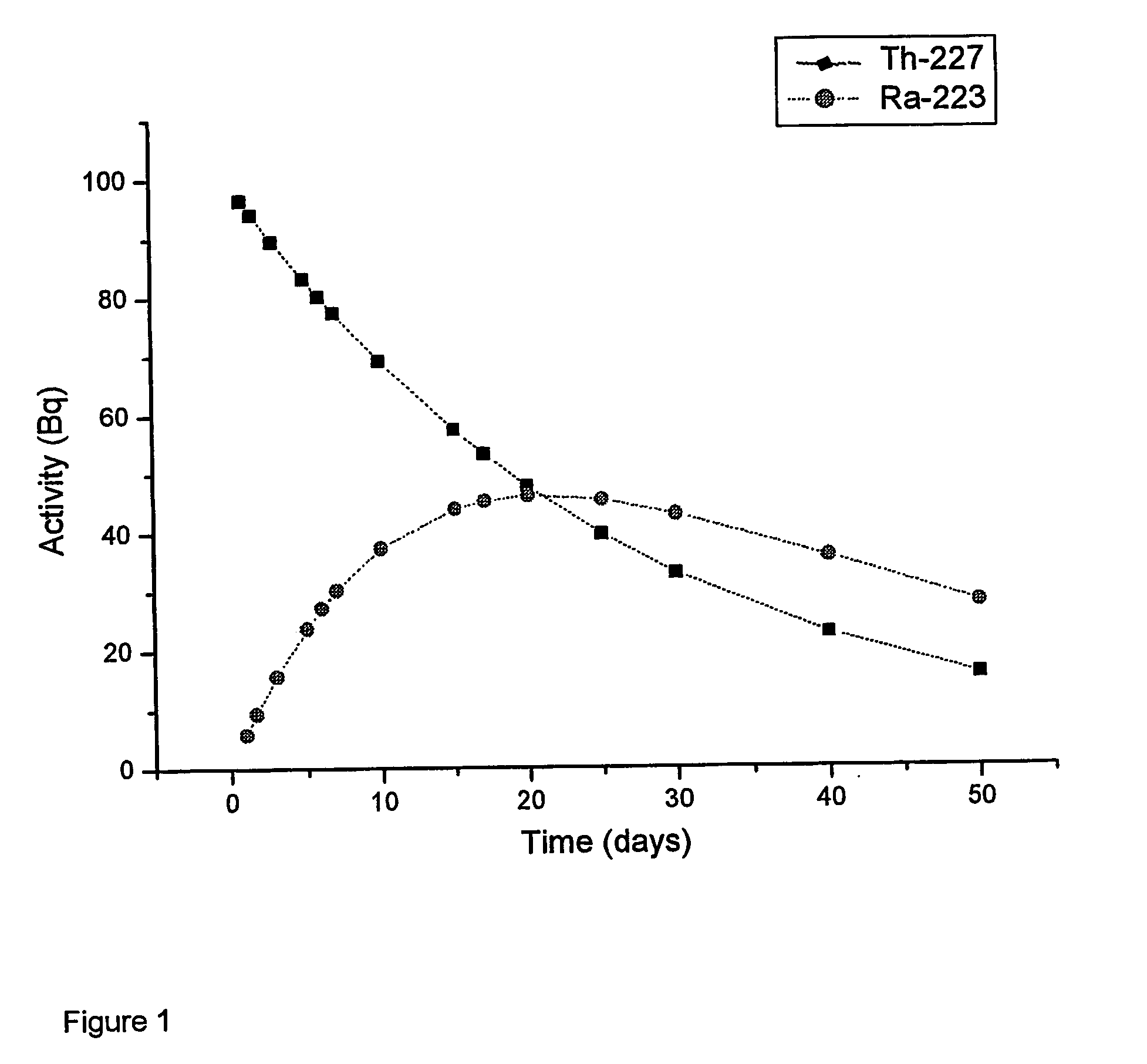Thorium-227 for use in radiotherapy of soft tissue disease
a soft tissue disease and radiotherapy technology, applied in the field of thorium227, can solve the problems of difficult commercialization of radiopharmaceuticals based on these radionuclides, high energy recoil of the daughter nucleus following alpha decay, and the potential to release large quantities of damaging radiation into healthy tissues
- Summary
- Abstract
- Description
- Claims
- Application Information
AI Technical Summary
Benefits of technology
Problems solved by technology
Method used
Image
Examples
example 1
Estimate of the In Vivo Generation of 223Ra Following Administration of a Thorium Labeled Compound with a Whole Body Retention Half-Life of 12 Hours
[0073] The effective half-life for 227Th (assuming negligible fraction of 227Th retained in tumor) would be 1 / T1 / 2effective=1 / T1 / 2phys+1 / T1 / 2biolT1 / 2effective=0.487 days. The fraction of 227Th decaying in the body would be equivalent with T1 / 2effective / T1 / 2 physical=0.0262 which would correspond to the generation of 6.1×109 atoms of 223Ra per 100 kBq of 227Th injected. The toxic component from the daughter nuclides should be roughly equivalent to a radium-223 dosage of 4.3 kBq of 223Ra per 100 kBq (initial) of 227Th. Decay of 0.0262 of the administered thorium equivalent to 2.6 kBq of fully retained 227Th for every 100 kBq administered.
example 2
Estimate of the In Vivo Generation of 223Ra Following Administration of a Thorium Labeled Compound with a Whole Body Retention Half-Life of 4 Days
[0074] Calculated as in Example 1, the T1 / 2effective=3.3 days for body clearance. This is equivalent to a fraction of 0.176 of the Th atoms decaying in the body. This corresponds to 4.1×1010 atoms of 223Ra generated per 100 kBq of 227Th. The toxic quantitatively retained on the column. It was also verified in a control experiment with 227Th in a “reaction” solution without the chelator, that both 227Th and 223Ra were >90% retained on the column). The unpurified reaction product of 227Th-p-SCN-Benzyl-DOTA was used for labeling of rituximab.
example 5
Preparation of a 227Th Based Radioimmunoconjugate (RIC)
[0075] The labelling was performed via a two-step procedure, the first step being the combination of the 227Th and the chelator (described in Example 4). The second step is the coupling of the radioactive chelator to the antibody. The reaction solution (Example 4) was added to 200 μl of rituximab (10 mg / ml, Mabthera®, F. Hoffmann-La Roche AG, Basel, Switzerland) and the reaction solution adjusted to pH˜9 by adding approximately 100 μl of 1 M Na2CO3 / NaHCO3. The reaction solution was mixed gently on a shaker (Thermomixer Comfort Eppendorf AG, Hamburg, Germany) at 35° C. for 1 h. Thereafter, 50 μl of 10 mM diethylenetriamine pentaacetic acid (DTPA, Fluka Chemie AG Buchs, Neu-Ulm, Germany) and 200 μl of 0.2 M glycine in saturated borate (sodium tetraborate decahydrate, from Fluka) and the incubation was continued for 5 minutes. Thereafter, the reaction mixture was transferred to a Sephadex G-25 PD 10 column and eluted with 1% BSA (...
PUM
| Property | Measurement | Unit |
|---|---|---|
| Time | aaaaa | aaaaa |
| Radioactive decay specific activity | aaaaa | aaaaa |
| Radioactive decay specific activity | aaaaa | aaaaa |
Abstract
Description
Claims
Application Information
 Login to View More
Login to View More - R&D
- Intellectual Property
- Life Sciences
- Materials
- Tech Scout
- Unparalleled Data Quality
- Higher Quality Content
- 60% Fewer Hallucinations
Browse by: Latest US Patents, China's latest patents, Technical Efficacy Thesaurus, Application Domain, Technology Topic, Popular Technical Reports.
© 2025 PatSnap. All rights reserved.Legal|Privacy policy|Modern Slavery Act Transparency Statement|Sitemap|About US| Contact US: help@patsnap.com



